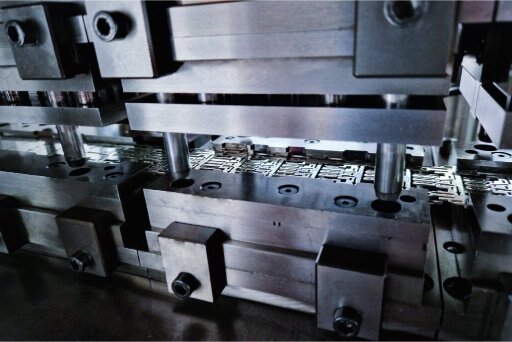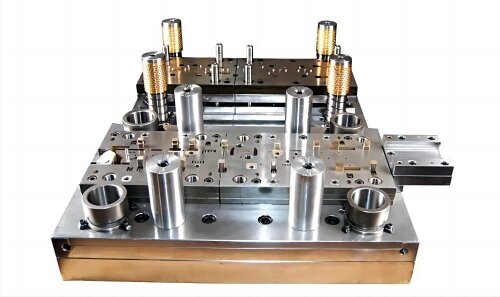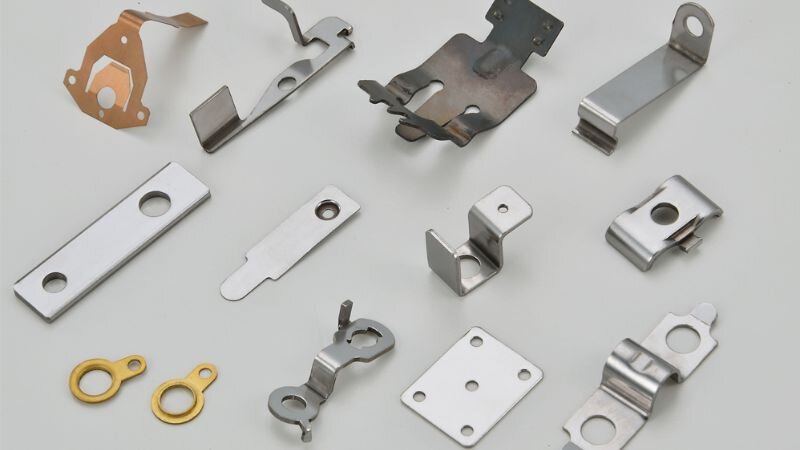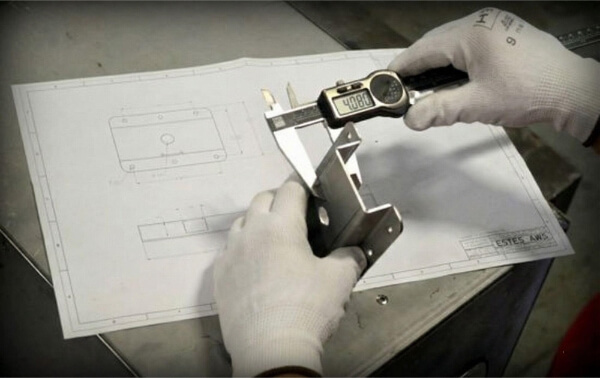Получение точного предложения может сэкономить время, снизить затраты и предотвратить задержки в производстве. Многие инженеры, дизайнеры и менеджеры по закупкам сталкиваются с изменением цен из-за неполноты или неясности первоначальных деталей проекта.
В этом руководстве объясняется, что влияет на расценки на штамповку листового металла, какая информация нужна производителям и как правильно подготовить чертежи и данные. Следуя этим шагам, вы сможете получить точную и надежную смету как для прототипов, так и для крупных партий продукции.
В следующих разделах мы рассмотрим основные факторы, определяющие расценки, такие как тип материала, сложность детали, объем производства, допуски и оснастка. Мы также укажем на распространенные ошибки при составлении сметы, которых следует избегать. Каждый раздел призван помочь вам уложиться в сроки и бюджет.

Ключевые факторы, влияющие на котировки штампов
Точные расценки на штамповку листового металла зависят от многих факторов. Понимая, что влияет на цену, вы сможете подготовить полную информацию о проекте и избежать неожиданностей в дальнейшем.
Тип и толщина материала
Тип материала оказывает большое влияние на конечную стоимость. Такие распространенные металлы, как алюминий, нержавеющая сталь и холоднокатаная сталь, сильно отличаются по цене и характеристикам. Более мягкие металлы легче штамповать, но для прочности могут потребоваться более толстые листы.
Более твердые металлы, такие как нержавеющая сталь, выдерживают большую нагрузку, но при этом быстрее изнашивают оснастку. Толщина также имеет значение. Более толстые листы требуют большего усилия пресса и более мощных штампов, что увеличивает затраты на оборудование и энергию. При запросе цены всегда указывайте марку материала, толщину и любые специальные обработки.
Сложность деталей и особенности конструкции
Дизайн деталей влияет как на стоимость, так и на время производства. Простые детали, такие как кронштейны или плоские панели, штампуются быстро. Однако детали с изгибами, фланцы, или глубокая вытяжка В таких областях требуется более сложная оснастка. Для детальных конструкций также могут потребоваться более узкие зазоры и дополнительные операции, такие как удаление заусенцев или постукивание.
Добавление таких элементов, как ребра или тиснение, может повысить прочность, но также изменить давление формования. Даже такие мелкие детали, как форма углов или расположение отверстий, могут повлиять на износ инструмента и эффективность. Четкая и подробная модель CAD позволяет инженерам точно оценить эти элементы и составить более точное предложение.
Объем производства и размер партии
Количество играет важную роль в ценообразовании. При изготовлении небольших партий время на настройку и программирование распределяется между меньшим количеством деталей, поэтому стоимость единицы продукции выше. Крупные партии, с другой стороны, выигрывают от автоматизации и сокращения трудозатрат, что снижает стоимость одной детали.
Размер партии также определяет тип оснастки. Прогрессивные штампы лучше всего подходят для больших объемов, а одноступенчатые или составные штампы - для прототипов или малотиражных партий. Когда вы запрашиваете цену, сообщите как размер первого заказа, так и предполагаемый объем повторных партий. Это поможет производителям спланировать наиболее экономически эффективное решение по оснастке.
Допуски и требования к чистоте поверхности
Для достижения более жестких допусков требуется больше времени и навыков. Для соблюдения очень малых размеров часто требуются специальные штампы и более частая настройка инструмента.
Отделка поверхности также влияет на цену. Дополнительные процессы, такие как полировка, покрытие, или рисование увеличить объем работ по обработке и контролю. Четкое указание допусков и деталей отделки помогает избежать лишних затрат при соблюдении требований к качеству. Если возможно, сохраняйте гибкость некритичных размеров, чтобы сохранить доступность производства.
Как подготовить чертежи и данные для котировки?
Хорошая подготовка позволяет быстрее и точнее составить коммерческое предложение. Четкие чертежи, детали материалов и информация о поставках экономят время общения и помогают избежать дорогостоящих ошибок в дальнейшем.
Предоставление полных 2D и 3D чертежей
Точные чертежи - основа надежного предложения по штамповке. Полный 2D-чертеж должен показывать размеры, допуски, линии сгиба, размеры отверстий и любые специальные примечания. Эти детали помогут инженерам понять вашу конструкцию и проверить, можно ли ее легко изготовить.
3D-модели CAD дают более четкое представление о форме детали. Они позволяют инженерам проверить пределы формовки, помехи и поток материала. Без надлежащей 3D-модели трудно судить о конструкции инструмента или возможных проблемах. Распространенные форматы включают файлы STEP, IGES и SolidWorks. Отправка как 2D-, так и 3D-версий гарантирует, что ваш проект будет понят правильно.
Укажите требуемое количество и сроки поставки
Количество напрямую влияет на стоимость и выбор оснастки. При небольших партиях могут использоваться мягкие или одноступенчатые штампы, в то время как при крупносерийном производстве для повышения эффективности часто требуются прогрессивные штампы. Размер заказа влияет на время наладки, расход материалов и выбор пресса.
Четко определите и график поставок. Срочные проекты могут потребовать сверхурочной работы или дополнительных смен, что может увеличить расходы. Если ваши сроки могут быть гибкими, сообщите об этом производителю. Это поможет им лучше спланировать производство и иногда предложить более низкие цены.
Уточните потребности в постобработке
Многие штампованные детали нуждаются в дополнительной обработке после формовки. Обычно это снятие заусенцев, сварка, нанесение покрытия, анодирование или покраска. Каждый из этих этапов увеличивает время, стоимость и требования к контролю.
Уточните, какая отделка или покрытие вам нужны. Укажите такие детали, как цвет, блеск поверхности или стандарты защиты от коррозии. Четкие инструкции помогут инженерам спланировать процесс в правильном порядке и избежать переделок. Чем более подробной будет ваша информация, тем более гладким и точным будет процесс составления коммерческого предложения.

Роль затрат на оснастку и штампы
Стоимость оснастки и штампов играет большую роль в общей цене штамповки листового металла. Они влияют на то, насколько эффективно могут быть изготовлены детали и насколько стабильной будет каждая деталь. Понимание этих затрат поможет вам лучше спланировать свой бюджет и принять более разумные решения по выбору поставщиков.
Инструментальная оснастка включает в себя формы, штампы и приспособления, которые придают металлу окончательную форму. Изготовление этих инструментов требует времени, точности и мастерства. Для простых деталей может быть достаточно одного штампа с базовой настройкой. Но для сложных деталей инженерам часто требуются многоступенчатые или прогрессивные штампы, которые выполняют несколько этапов за один цикл. На их разработку, обработку и испытания уходит больше времени, что увеличивает первоначальную стоимость.
Однако хорошо изготовленные штампы могут прослужить тысячи или даже миллионы циклов. Хотя первоначальные инвестиции могут показаться высокими, они обычно окупаются со временем за счет снижения стоимости единицы продукции и повышения скорости производства. Прочная, долговечная оснастка также минимизирует время простоя и помогает поддерживать постоянное качество деталей.
Распространенные ошибки, которые приводят к неточным цитатам
Одна из распространенных проблем - предоставление неполных или нечетких чертежей. Отсутствие размеров, допусков или данных о материалах заставляет инженеров строить догадки, что часто приводит к неправильной оценке стоимости. Всегда предоставляйте полные 2D- и 3D-чертежи с указанием основных деталей, таких как направление изгиба, размеры отверстий и толщина детали.
Еще одна ошибка - не указание требований к материалу. Различные марки стали или алюминия имеют разную прочность, вес и стоимость. Если марка материала и толщина не указаны четко, производители могут основывать цену на общих предположениях. Это может привести к изменению цены после начала производства. Предоставление точной информации о материале гарантирует, что расценки будут соответствовать реальным условиям производства.
Нечеткие инструкции по последующей обработке также являются частой проблемой. Такие этапы, как сварка, полировка, покраска или нанесение покрытия, могут увеличить как время, так и стоимость. Когда эти детали отсутствуют, первоначальная цена может показаться ниже, но впоследствии увеличиться после корректировки. Чтобы получить полную и точную смету, лучше всего заранее описать все потребности в отделке.

Как запросить у Shengen предложение на штамповку листового металла?
Запросить смету в компании Shengen очень просто, если вы подготовите правильную информацию. Наш процесс разработан таким образом, чтобы сэкономить время, сократить количество обратных связей и быстро предоставить точную смету.
Начните со сбора файлов конструкции. Отправьте как 2D-чертежи, так и 3D-модели CAD, чтобы наши инженеры могли полностью понять геометрию детали. 2D-чертеж должен включать размеры, допуски и примечания. 3D-файл - например, в формате STEP, IGES или SolidWorks - поможет нам проверить технологичность и конструкцию инструмента. Если 3D-модель недоступна, подойдет подробный 2D-чертеж с полными измерениями.
Далее укажите сведения о материале. Укажите тип металла, марку, толщину и любые стандарты поставщика. Например, нержавеющая сталь 304 и холоднокатаная сталь CR1018 отличаются по прочности, коррозионной стойкости и цене. Четкие данные о материалах гарантируют, что расценки отражают реальные производственные потребности.
Затем сообщите количество и график поставок. Независимо от того, нужно ли вам 50 прототипов или 10 000 серийных изделий, эта информация определяет тип оснастки, время наладки и стоимость каждой детали. Если у вас есть гибкие сроки или планы на будущие партии, укажите их, чтобы получить более выгодное предложение.
Также укажите все необходимые этапы последующей обработки, такие как удаление заусенцев, анодирование, покраска или нанесение покрытия. Каждый процесс добавляет время и стоимость, поэтому четкие инструкции помогут нам составить точную смету и избежать последующего пересмотра.
Наконец, укажите свои контактные данные и любые особые указания по проекту, например, стандарты контроля, предпочтения по упаковке или необходимость сертификации. После получения информации команда инженеров Shengen изучает данные, подтверждает детали и предоставляет подробное коммерческое предложение - как правило, в течение короткого времени.
Готовы начать свой следующий проект? Получите быстрое и точное предложение по штамповке листового металла уже сегодня. Загружайте свои чертежи, делитесь своими требованиямиИ наши инженеры быстро ответят вам четким, конкурентоспособным предложением - без задержек и догадок.
Привет, я Кевин Ли

Последние 10 лет я занимался различными формами изготовления листового металла и делился здесь интересными идеями из своего опыта работы в различных мастерских.
Связаться

Кевин Ли
У меня более десяти лет профессионального опыта в производстве листового металла, специализирующегося на лазерной резке, гибке, сварке и методах обработки поверхности. Как технический директор Shengen, я стремлюсь решать сложные производственные задачи и внедрять инновации и качество в каждом проекте.



